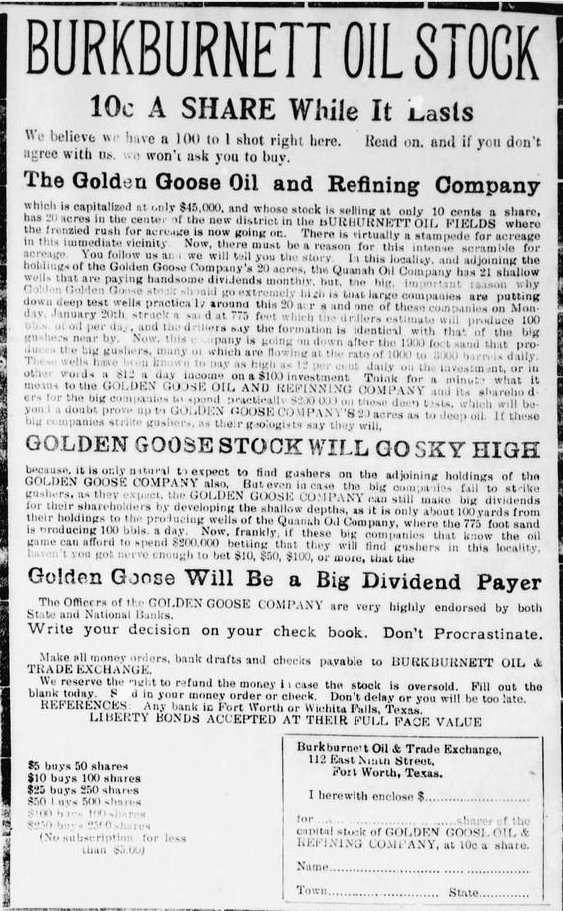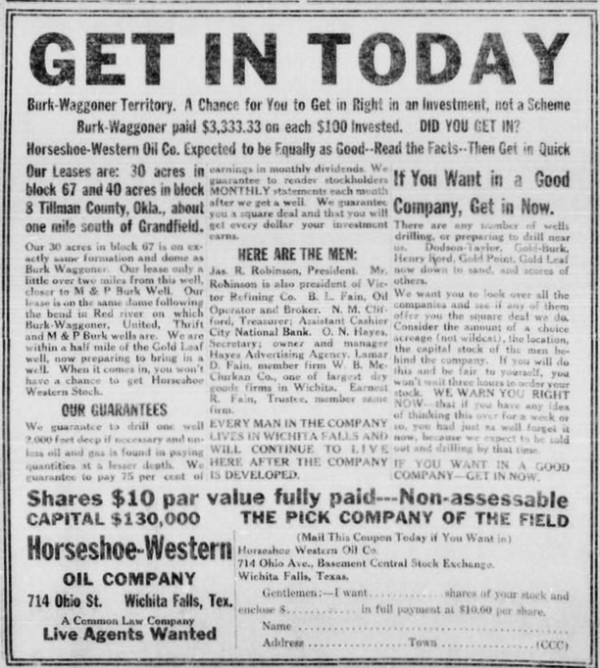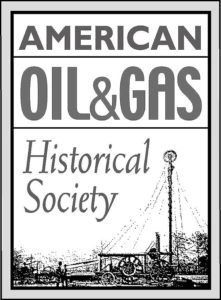by Bruce Wells | Mar 26, 2025 | Petroleum Pioneers
Some thought the 1911 oil discovery at Electra was an April Fool’s Day joke.
When a geyser of oil erupted from the Clayco No. 1 well near Electra on April 1, 1911, the giant oilfield discovery launched a boom that brought prosperity and more drilling to North Texas. Lawmakers would name Electra the “Pump Jack Capital of Texas.”
Just south of the Red River, Electra was a small, cotton-farming community barely four years old when petroleum exploration companies rushed to North Texas in 1911. (more…)
by Bruce Wells | Sep 9, 2013 | Petroleum Companies

Newspaper advertisements made many incredible claims, including: “Think for a minute what it means to the olden Goose Oil and Refining Company and its shareholders for the big companies to spend practically $200,000 on these deep tests, as it is only 100 yards from from the producing wells…”Golden Goose Oil and Refining Company promoted sales of its stock in Texas newspapers during February of 1919, urging investors to buy at “10 cents A Share While It Lasts.”
The company purported to own a 20-acre lease in the prolific Burkburnett oilfield – where there was a “frenzied rush” and “virtual stampede for acreage in this immediate vicinity.”
The company’s stock was available at the Burkburnett Oil & Trade Exchange in Fort Worth. Advertisements proclaimed that “Golden Goose Stock Will Go Sky High.” It didn’t.
Golden Goose Oil and Refining Company certificates may have value to scripophily collectors. Learn more about the North Texas petroleum history in “Boom Town” of Burkburnett.
___________________________________________________________________________________
The stories of exploration and production companies joining petroleum booms (and avoiding busts) can be found updated in Is my Old Oil Stock worth Anything? The American Oil & Gas Historical Society preserves U.S. petroleum history. Please support this AOGHS.ORG energy education website. For membership information, contact bawells@aoghs.org. © 2018 Bruce A. Wells.
by Bruce Wells | Jul 24, 2013 | Petroleum Companies

Probably formed during the North Texas oil booms of the 1920s, Horseshoe-Western Oil Company of Wichita Falls, Texas, did not leave much of a footprint after the Great Depression.
The company began with leases on 30 acres in Tillman County, Oklahoma, just across the Red River Texas border of the booming oil town of Wichita Falls.
The new company guaranteed to drill at least one well to a maximum depth of 2,000 – promising to pay 75 percent of earnings in monthly dividends to investors if the well was successful.
The company’s “Get in Today” advertisement in the Corpus Christi newspaper proclaimed riches to be had by acting quickly.
“We want you to look over all the companies and see if any offer you the square deal we do,” the company added, noting its leadership would remain in Wichita Falls. It claimed to have leases on a famous producing region.“We warn you right now – that if you have any idea of thinking this over for a week or so, you had just as well forget it now, because we expect of be sold out and drilling by that time,” the Wichita Falls oil company declared.
The Burkburnett oilfield, discovered on July 29, 1918, on S.L. Fowler’s farm, had brought thousands of people to North Texas. Twenty trains ran between Burkburnett and Wichita Falls every day.
With only $130,000 in capitalization, it does not appear Horseshoe-Western Oil Company survived. Learn more about North Texas petroleum history in Pump Jack Capital of Texas.
Please support the American Oil & Gas Historical Society with a donation.



